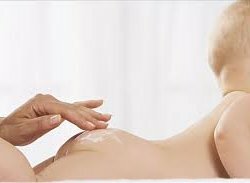Diaper dermatitis
 The skin of a newborn is very tender. She is sensitive to the slightest irritation, so parents often face a problem in choosing creams, diapers, clothes and the like. Surely almost every mother of the crumbs faced such a problem as diaper dermatitis. At first glance, such a symptom may seem harmless. However, if you do not take the necessary measures in time, the skin condition will worsen. In this article, we will examine with you what diaper dermatitis is, what its symptoms are and how to avoid it.
The skin of a newborn is very tender. She is sensitive to the slightest irritation, so parents often face a problem in choosing creams, diapers, clothes and the like. Surely almost every mother of the crumbs faced such a problem as diaper dermatitis. At first glance, such a symptom may seem harmless. However, if you do not take the necessary measures in time, the skin condition will worsen. In this article, we will examine with you what diaper dermatitis is, what its symptoms are and how to avoid it.
So, let's deal with you, what is diaper dermatitis? This is skin irritation in the thighs and buttocks of the baby. Diaper dermatitis can occur as a result of physical, mechanical and microbial factors. Most often it occurs in children up to six months.
Pediatricians noticed that in infants who are breastfed, diaper dermatitis occurs much less frequently. This is due to the fact that with artificial feeding enzyme activity is very high, which is why the stool is more caustic and very irritating to the tender baby skin.
Diaper dermatitis affects negatively the psychophysical and nervous system of the baby. After a crumb feels terrible discomfort: itching, burning and even painful sensations. This provokes various disorders from the nervous and vascular systems.
Features of diaper dermatitis
The cause of the development of diaper dermatitis is a feature of the baby's skin. Below we will consider these features:
- Immaturity of the skin. Each baby is born with a relatively immature skin integument - the epidermis is very thin, so it is very vulnerable. In addition, the dermal connective elements are not completely developed, and the basal membrane is very fragile.
- Moisture content. In the skin cells of babies contains a small amount of moisture. The lack of this moisture leads to skin cells becoming more fragile and easily injured.
- Imperfection of various functions. The immune and thermoregulatory functions of the skin in neonates are poorly developed.
All these factors increase the risk of diaper dermatitis. However, the provoking factors are:
- Elevated body temperature. Parents, worrying that the crumb will freeze, dress it as warmly as possible. But pediatricians and dermatologists do not recommend this, since overheating of the skin leads to the development of diaper dermatitis.
- Friction and humidity. Increased humidity, as well as frequent friction of the skin on a diaper or diaper can also lead to the appearance of diaper dermatitis. Therefore, in no case should parents leave the baby in wet diapers even for a short time. In addition, it is very important that the diapers are made of natural fabric that absorbs moisture well. The fabric should be soft, so as not to injure the baby's skin.
- Effects on the skin of biological fluids. With prolonged exposure to the skin of sweat, urine and stool, diaper dandruff can occur. The longer these biological fluids affect the skin, the more affected the skin.
- Pathogenic microflora and fungal diseases also lead to the appearance of diaper dermatitis.
- Diarrhea. With diarrhea, the skin of the crumbs becomes very vulnerable.
- Switch to a new food or food. Diaper dermatitis occurs if the baby is fed with an artificial mixture, new food or other brand of infant formulas. It happens because the composition of the feces changes.
Statistics show that more than half of babies under a year face with diaper dermatitis. In addition, girls suffer from this problem much more often than boys. Diaper dermatitis in every baby is expressed in different ways. Someone can have slight reddening of the skin, and someone can have a very extensive defeat.
Prevention of diaper dermatitis
To prevent the appearance of diaper dermatitis, you must adhere to some rules:
- Cleansing the skin. The skin of the baby should always be clean. To clean the skin, you need to use clean water and special children's hygiene products, the level of pH in which is neutral. In the detergent components there should be no alkaline components.
- Use of protective equipment. Doctors recommend after each change of a diaper to put on a region of the thighs and buttocks a special protective cream. Some parents use medicinal creams for the prevention, which contain hormonal substances and antibiotics. Such cream should be used only for the intended purpose, as they can lead to the development of serious complications.
- Rules for the combination of care products. Many parents simultaneously use a powder and a cream for a diaper. But this combination is very harmful for the tender baby skin. Rolled powder can injure the skin.
Treatment of diaper dermatitis
Diaper dermatitis is not so easy to cure. Therefore, my mother will have to make a lot of efforts for this. It is very important to observe the right treatment. First of all, you need to turn to the pediatrician. The doctor will help to eliminate other diseases. In addition, he will appoint suitable drugs for treatment.
Mom should make air baths for crumbs. It is necessary to put the baby as often as possible without diapers, diapers and panties so that air enters the affected areas. Thus, the damaged skin will be dried and very soon there will be an improvement. Very effective baths with a solution of potassium permanganate. But be careful, there should not be undissolved crystals in the water, since they can cause a burn of delicate skin. The solution itself should be pale pink. Baths should be done as often as possible.
You should never forget about personal hygiene. Immediately after the baby goes to the toilet, it must be washed using special detergents. If you follow all the above recommendations, the diaper dermatitis will very quickly cure.
Finally I want to note that disposable diapers in times reduce the risk of diaper dermatitis. They are hygienic and absorb moisture well, therefore, baby skin will always remain dry and clean. In addition, diapers are simply indispensable on the road or when there is no way to properly wash the baby.
However, it is very important to properly use disposable diapers. Some parents try to save on them, so they change diapers only when they are completely nourished. This can not be done, since such use of diapers can lead to the appearance of diaper dermatitis.
Diapers need to be changed every two to three hours, they need to be changed after each act of bowel movement. Feces are not absorbed into diapers, so they can damage children's skin and lead to the development of diaper dermatitis. Do not forget about the use of special cosmetics that are designed for a diaper. Additional protection will protect the baby from the appearance of diaper dermatitis.



